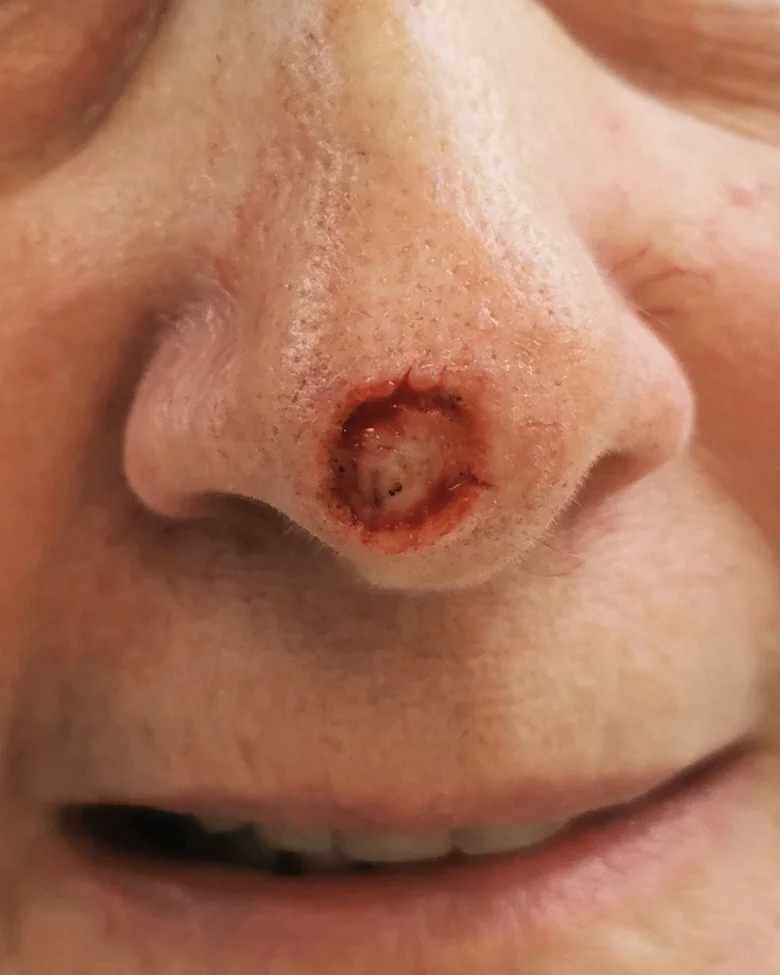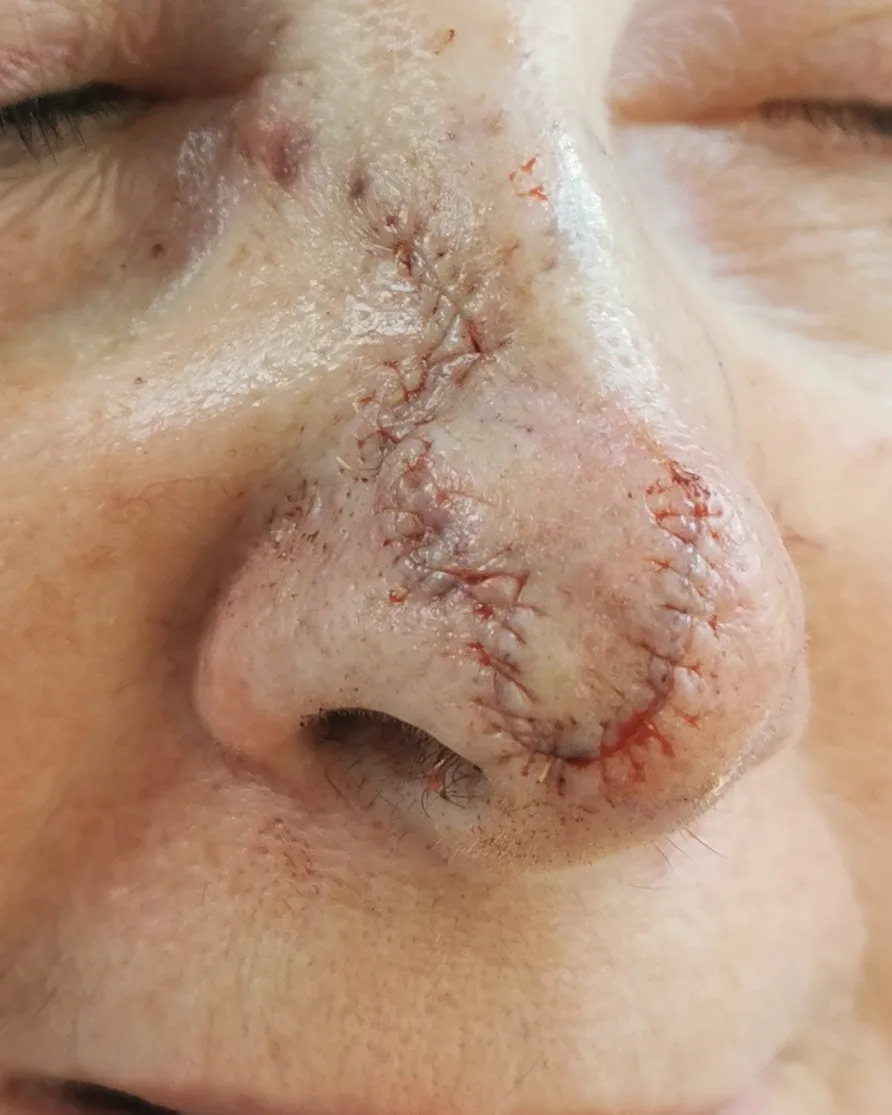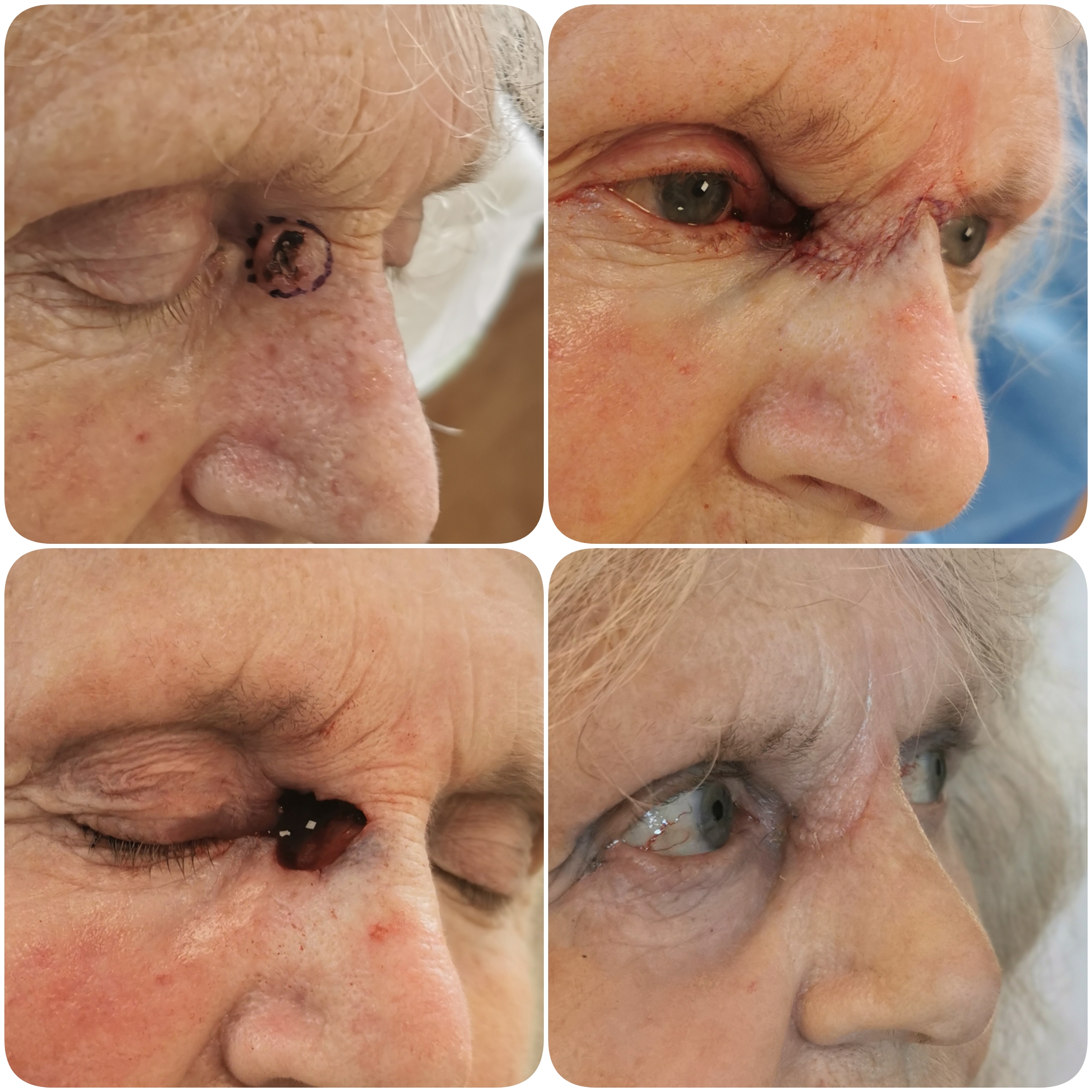Mohs micrographic surgery is a specialised surgical technique to remove skin cancers typically located on the central face. It was initially described by Dr Frederic Mohs, a general surgeon from Wisconsin in the United States in the 1930s.
The advantage of Mohs surgery over other forms of surgery is it allows preservation of as much healthy skin as possible while also offering the highest cure rate. Without Mohs , the surgeon has to take a much larger area of healthy skin around the cancer to ensure that it is fully removed. Despite this the cancer can still be incompletely removed and/or regrow at a later date leading to even more extensive surgery. Envisage a tree with roots. In order to remove all the roots a lot of ground has to be removed. With Mohs surgery only the tree and its roots are removed preserving all the healthy surrounding ground.
Mohs micrographic surgery is considered the ‘gold-standard’ treatment for certain types of skin cancer especially those on the nose, close to the eye, recurrent cancers, cancers that are large and cancers occurring in young people.
Are you on an NHS waiting list, but would like to have treatment as soon as possible?
Mohs micrographic surgery is available within the NHS for patients with skin cancers typically on the face or ears that their clinician feels warrant this specialist technique. Sadly however, waiting times can sometimes be longer than patients wish to wait, or the appointment is not available at a time that is convenient. Having Mohs surgery to your nose for instance often requires a few weeks to fully heal especially after a skin flap or graft is used to repair the Mohs defect.
Planning for this post-operative period can be challenging. Some patients choose to have Mohs surgery done privately. Patients must take careful consideration about leaving the NHS waiting list to have their Mohs surgery done privately. The first is cost. Mohs surgery is expensive. Depending on the size of the skin cancer (basal cell carcinoma or squamous cell carcinoma are the most common cancers of the skin treated using Mohs surgery) and its anatomical site will affect the complexity of the surgery. A specialist laboratory is required to process the specimens in as well as the technical skills of a biomedical scientist to produce high quality slides for the Mohs surgeon to read. All of this adds to cost. The other factors are where will the surgery be done and what is the after care. Dr Toby Nelson performs Mohs surgery on a weekly basis within his NHS practice in Plymouth. He receives referrals from across the southwest including patients from all of Cornwall, Exeter, Torbay, Taunton, Bournemouth.
Looking for private Mohs surgery in Devon?
Dr Nelson now has the unique offering of private Mohs surgery at the world class facility Wood MediSpa just off the A30 near Okehampton in Devon. Although hidden away in its own 30 acres of formal gardens and parkland it is only 25 minutes’ drive from Exeter, an hour from Plymouth and an hour from Taunton. Wood Medispa is a meticulous conversion of a beautiful Dan Gibson designed Arts and Crafts manor house, now home to a state-of-the-art private hospital facility. Original features have been retained within the building to give a sumptuous finish, yet brought up to the modern standard expected of a world class MediSpa.
The in house chef prepares fresh meals daily for all patients. Ingredients often grown in the kitchen garden. Patients can relax in private comfortable surroundings while awaiting the various stages of their Mohs surgery. Nothing is too much to ask of Dr Nelson and his team at the Wood Medispa. Dr Nelson and team offer a bespoke journey from first consultation through to treatment. Aftercare is tailored to patient’s `need. The surgical facility is purpose build for Mohs surgery with a state of the art theatre and laboratory all within the walls of one of England’s finest buildings. Overnight rooms will soon be available for patients and loved ones. Dr Nelson works closely with the plastic surgeons at the Wood should a multidisciplinary team be required in a patients care.
Whats different about Mohs surgery to standard excision biopsies?
Mohs surgery allows 100% of the excised tissues margins to be assessed under microscope on the same day as your operation. If the area of skin removed shows any cancer remaining, you can have further surgery that same day to completely remove the cancer. In traditional surgery less than 1% of the tumour margin is assessed and this takes places days to weeks following the operation. By this point, if it shows that the cancer was not fully removed, the patient then needs to have far more extensive surgery.
During Mohs surgery the cancer is carefully marked out before being removed with a 2mm rim of normal skin. Dr Nelson then carefully scores the specimen to relax the edges of the excised skin down into the same plane as the base. This turns a 3-dimensional structure into a 2-dimensional structure. Once the sides and base of the excised skin has been fully ‘relaxed’ it is processed so the entire peripheral margin and the deep margin are visualised in a single plane using a high powered microscope. This allows for examination of 100% of the margin. Any cancer cells found are carefully mapped back to the patient. The patient is returned to the operating room. More anaesthetic is injected before a second stage is performed to precisely remove only the area of skin involved. This process is repeated until the entire cancer has been removed. You therefore keep as much healthy tissue as possible, which is so important for cosmetic reasons on your face and neck.
In conventional surgery a bread-loafing method is used to examine the cancer. The excised cancer is sliced up like a loaf of bread. Only a handful of slices will be assessed often days to weeks after the operation.
The huge advantages of Mohs surgery are reflected in the price. Mohs takes longer to perform but in Dr Nelson’s opinion if you are going to treat a skin cancer it is better to treat it properly first time rather than try to cut corners and end up with a bigger problem later on.
Who performs Mohs micrographic surgery?
Dermatologists with additional advanced surgical training perform Mohs micrographic surgery. This is usually in the form of a dedicated fellowship. Dr Nelson is one of the UK’s only surgeons to have undergone vigorous International Fellowship surgical training in Mohs micrographic surgery, dermatopathology and surgical reconstruction. As one of only a handful of dermatological surgeons in Europe who are accredited of the American College of Mohs Surgery (www.mohscollege.org) you will be in safe hands.
Dr Toby Nelson is one of only a handful of Mohs surgeons in Europe to have completed a fellowship affiliated to the ACMS. He owes this prestigious accreditation to his close friends, trainers and mentors Dr Paul Salmon and Neil Mortimer of the Skin Centre, New Zealand
Before & After









BOOK A CONSULTATION
For Wood MediSpa Okehampton please call: 01837 516629 | For The Duchy Hospital, Truro please call Claire on 07812 095769 or email: enquiries@tobynelsondermatology.com. A referral from your GP is preferred.
